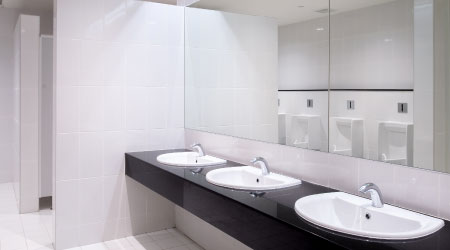Material Choices Greatly Affect High-Volume Restroom Durability
4. Choose the Right Materials. When it comes to materials, the right choice varies depending on the setting. At a corporate headquarters, for instance, "it's expected that employees will care about their toilet rooms," McCarthy says, so they are built with a higher level of finish. By contrast, in a school or a stadium, even though it is still important to provide attractive surroundings, durability and resistance to vandalism are paramount. Cole, the stadium architect, usually uses masonry, which can be made attractive even as it's durable. A setting such as an airport can have a "different level of finish," with ceramic tile, he says, because "you don't have people getting totally rambunctious."
Cole says that the minimum is sealed concrete, but psychologically, "when it's a low-cost finish, people treat it that way." The in-between choice is epoxy resin, and tile is the higher end.
Michael Lundeen of Legat Architects in Chicago says that on a tile floor, small tiles offer more slip resistance, but that also means more grout, which can absorb urine. He has found that a 6-by-6-inch tile with a very narrow grout works best. Bigger tiles are more slip-resistant if they are textured, but Lundeen says they are also harder to clean. Colored and sealed terrazzo concrete also offers a good look at a reasonable cost, Lundeen says.
For the airport project, Maiello used stainless steel to wrap from the floor to the wall, because luggage often chips vertical tile.
Materials in a school restroom must be tough, able to resist carving, and easily cleaned of graffiti. But, Remenschneider says, "You can do cool things with tile pattern and colors, so it doesn't feel like a highway restroom."
Sometimes the budget conflicts with the need to have materials that are durable enough, Remenschneider says. Districts that try to cut corners by using drywall instead of tile, for instance, will often regret it a few years later. But in a smaller restroom, durability is less paramount, she says, and "you can lay it out more as you would for office space."
5. Make Sustainability a Priority. As in every other aspect of design and building, sustainability has become more important to restrooms in recent years. Cole says that sports team owners have taken on more financial responsibility for their stadiums and are more interested in reducing their water and utility costs. "We believe sustainability is good for everyone, including the environment," he says. Even if a facility doesn't seek LEED certification, "we do what we see as good design."
Low-flow toilets and faucets are becoming the norm, Lundeen says. "It's just a matter of how much water you're trying to conserve." Powerful hand dryers are also becoming the default choice in order to reduce paper towel usage and make maintenance easier.
Waterless urinals can be tricky, Kier says: "The trouble is, people throw things in them and break the seal." Some building codes don't allow them. If they are installed, Kier says, they should be downstream from the flush toilets.
Denise Allacher, senior mechanical engineer at Leo A. Daly in Omaha, says that automatic sensors can be programmed for two levels of flush, depending on how long the user has been on the toilet; a longer time generates a more powerful flush.
Related Topics:














